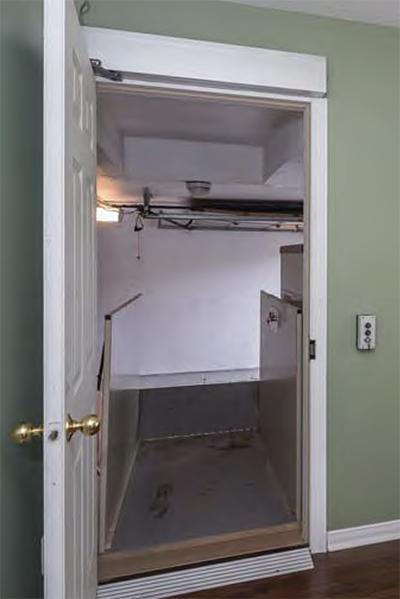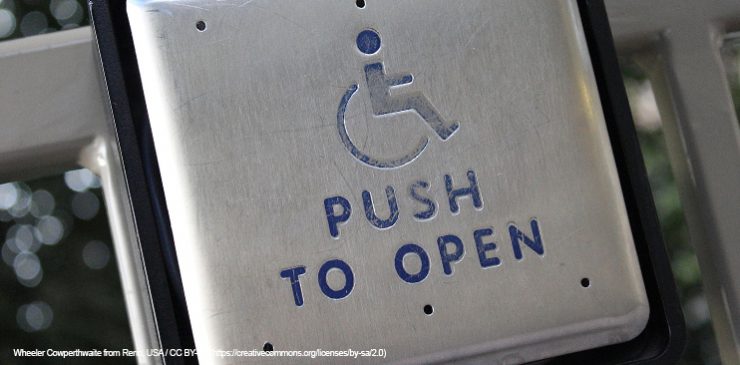How many times have you pushed a silver metal circle with the wheelchair symbol on it to open a door? I use them all the time when my hands are full. Sometimes I push them with my knee or my elbow.
Many of my clients rely on door operators as an essential part of their home. Door operators are most common in commercial buildings, restaurants, retail stores, residential apartment buildings and condominiums.
However, I’m seeing more and more door operators in single family residential settings. All of the door operators that I’ve encountered were designed for commercial / retail use and then modified for residential use. The two key features in an accessible home are an entrance solution and a bathroom solution. Both require opening doors. Operators for entrance and interior doors work on the same principle but require different motors and activators, i.e., buttons and sensors. I’m not going to get into mechanical specifications, however if you’re technically inclined, I would be happy to connect you with Nigel Nambiar at ASSA ABLOY Pedestrian Door Solutions (www.AssaAbloyEntrance.ca). I interviewed him at his Mississauga office for this article. The company has an impressive workshop that is set up with all kinds of door operators and activators.
Door operators are powered by electricity. A regular plug outlet connection is adequate. If a wall plug is not available, a new line will need to be installed by an electrician. A typical residential door
opener is shown in the picture. The mechanical components, including the motor, are located within the silver rectangular box. A metal arm connects the door to the opener and it moves the door open and closed.
When it comes to door operators in residential homes, the most common use is on the entrance door – either the accessible entrance door of a house, or the front door to a condominium suite.
Entrance doors on houses are often heavy and susceptible to the effects of Mother Nature such as wind and rain. Condominium entrance doors are usually solid fire rated material and can be subjected to air pressure within the building. Both locations need openers with strong motors.

garage with opener, electrical plug, and strike plate.
In addition to powering the door, an entrance opener can be connected to a strike plate mechanism that controls the door latch. This ensures the door can be locked.
Openers can be programmed to keep the door open for a specific period of time. This will vary from person to person depending on their speed of travel.
Interior doors are usually lighter and aren’t susceptible to wind or air pressure so they don’t require as much power and therefore can have smaller motors. Interior door latches can be removed so a power strike plate is not necessary.
In order to activate a door opener, a sensor needs to be triggered by a door activator. This can be accomplished in a number of ways. The most common is the circular metal button I mentioned earlier. A company called Camden Door Controls (www.CamdenControls.com) has a selection of activator buttons in their online catalogue including a 36” long Column™ plate switch. I have not seen one of these in use, but I can visualize the benefit to being able to push the plate from various heights including with a wheelchair foot pedal.
Other options include pressing a button on a remote control, swiping a proximity card (similar to a credit card) or a FOB (about the size of a quarter that hangs on a key chain), or movement in front of a motion sensor. For entrance doors that are connected to door locks, a remote control, FOB or proximity card that can be encoded for security is needed.
For condo buildings, proximity cards or FOBs can be programmed to open multiple common area doors throughout the building including the parking garage entrance. Condo owners usually have a separate door activator for their suite entrance.
Thought needs to be given to the type of door activator that works for you. If you’re not able to reach out your arm to swipe a card, then a remote control with a button might be more suitable. If you’re looking at buying a condo and need access to the parking garage, this is an important consideration.
Door FOBs can also be used for attendant care staff – to provide access and to track data. I worked with a client who gave all of his attendants their own FOB; they swiped it each time they arrived and
left. This information was stored in a computer and helped track staff hours.
As with all home modifications it’s important to do your research to make sure the products you’re buying will meet your needs and they are professionally installed. In addition to ASSA ABLOY, the experts I talked with also use door operators from GYROTECH and STANLEY.
If you’d like more info on door operators please let me know and I’d be happy to connect you with the companies I interviewed for this article.
 Jeffrey Kerr, Broker, Barrier Free Real Estate Specialist
Jeffrey Kerr, Broker, Barrier Free Real Estate Specialist
RE/MAX Unique Inc., Brokerage
416-424-2222
www.AccessibleHomeFinder.com
Facebook: @AccessibleHomeFinder.com
Twitter: @barrierfreeRE











